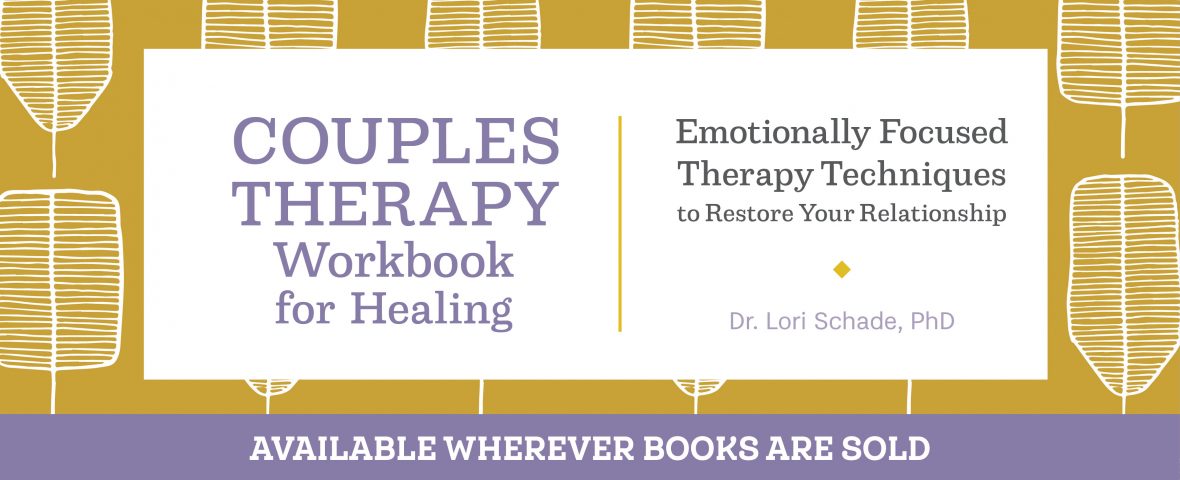
I’m so excited for the couple’s workbook I have coming out this month. Check it out by clicking here.
It’s not uncommon for me to request of a partner that he or she, “Look your partner in the eyes and tell him or her,” something important they just said while looking at me. I can predict that much of the time, I will get a protest of, “I’m pretty sure they just heard me,” to which I will say, “Right, but it’s so different if you say it to them—can you just try it, right now, look him or her in the eye and say what you just said to me?”
That might sound somewhat awkward, and I try to reduce the awkwardness as much as I can with space, but awkward or not, it doesn’t seem that difficult, does it—to just make eye contact with a partner and tell them something perhaps a tiny bit vulnerable that they shared with me, with eye contact?
Eye Contact is Vulnerable
More often than not, couples really struggle to make eye contact at all, much less maintain it for more than a few seconds. Even when couples turn toward each other to initiate an interaction, they generally will look anywhere except in a partner’s eyes. If I ask them to look in their partner’s eyes, they will quickly glance at their eyes and glance away.
Another thing that happens is that they might take the risk to look a partner in the eye, but the partner is looking somewhere else as well, so the couple is literally taking turns NOT looking at each other. It’s really quite interesting to watch because it is such a common display for how vulnerable it can feel to make mutual eye contact and more so to sustain mutual eye contact.
From the outside, when I see it happening, I usually feel a little bit sad because I know it’s likely the symptom of emotional distress. My informal assessment is that the more emotionally unsafe the relationship feels, the more partners struggle to make and maintain eye contact.
Eye Gazing and Pair Bonding
Eye gazing is a common connecting behavior in pair bonding, and is associated with the release of oxytocin. Courting couples engage in eye gazing more than couples who are not romantically involved. Some studies have suggested that the higher the relationship quality, the more couples engage in eye gazing.
Presumably most of the couples who come to see me are enduring at least mild distress, so it makes sense that eye contact is difficult. Many couples report that they can’t remember the last time they made eye contact with their partners. It’s a common symptom of disconnection.
When couples have fallen into a pattern of avoiding the type of closeness and intimacy associated with eye contact, it becomes harder and harder to feel comfortable with that level of closeness again.
I have adapted three exercises below for couples to practice variations of eye contact. The first two have other tasks included to reduce the raw vulnerability of simple eye gazing with no goal. For couples who want to try to practice emotional presence, this is a place to start. The exercises will be most effective in relationships in which safety is a foundation or in which both couples are actively working toward building safety for each other.
Eye Gazing Exercises
In each exercise, don’t worry about blinking. Blinking is normal and expected.
Exercise #1 (Eye gazing with breathing synchronization)
- Set a timer for between 90 seconds and three minutes
- Stand an arm’s length apart
- Reach out with your palms facing your partner’s palms and place them as close together as you can without touching
- As you gaze into each other’s eyes, bring your breathing into synchronization with your partner
- If you feel safe, you can choose to engage in a close hug, continuing to synchronize breathing
Exercise #2 (Eye gazing with emotional communication)
This exercise will require one person to be the emotional “communicator” and one to be the “receiver,” and then you will switch roles.
- Set a time for between 90 seconds and three minutes
- Stand or sit an arm’s length apart
- While you gaze into your partner’s eyes, try to communicate an emotion to your partner using only eye contact
- While maintaining eye contact, the other partner is trying to pick up on what emotion is being communicated
- After the timer goes off, check in and see how close you were to picking up on your partner’s emotion. Don’t be alarmed if you were off—this is a practice exercise and is only information for helping improve attunement in the future
- Switch roles and repeat
Exercise #3 (Simple eye gazing)
- Set the times for 90 seconds to 3 minutes
- Sit an arm’s length apart
- Simply gaze into your partner’s eyes, both attempting to pick up nuances of non-verbal communication as well as trying to communicate to your partner
- If you feel awkward and don’t know where to look, look slowly from the left eye to the right eye and back again
- If you get distracted, notice yourself breath and go back to eye gazing
- When the timer goes off, answer the following discussion questions:
- Did any emotions come up during the exercise and if so, which ones?
- Did any memories come up during the exercise and if so, which ones?
- What was the best part about the exercise?
- What was the most challenging part?
- What did you learn about yourself?
- What did you learn about your partner?
- How can eye contact improve your relationship?


 My recent song fix lately* is John Legend’s All of Me. One of my sons had me buy him the piano music so he could learn to play it after he heard it at Legend’s local concert appearance, and I have found myself humming it several times throughout the day. The lyrics of the emotionally evocative ballad capture what I believe most couples want from each other: All of me loves all of you, love your curves and all your edges, all your perfect imperfections. Give your all to me, I’ll give my all to you, you’re my end and my beginning, even when I lose I’m winning, ‘cause I give you all of me, and you give me all of you. The words imply complete security in a relationship. In a nutshell, we all want to be understood and accepted for who we are, even if we are imperfect, and that kind of safety provides fertile ground for complete intimacy.
My recent song fix lately* is John Legend’s All of Me. One of my sons had me buy him the piano music so he could learn to play it after he heard it at Legend’s local concert appearance, and I have found myself humming it several times throughout the day. The lyrics of the emotionally evocative ballad capture what I believe most couples want from each other: All of me loves all of you, love your curves and all your edges, all your perfect imperfections. Give your all to me, I’ll give my all to you, you’re my end and my beginning, even when I lose I’m winning, ‘cause I give you all of me, and you give me all of you. The words imply complete security in a relationship. In a nutshell, we all want to be understood and accepted for who we are, even if we are imperfect, and that kind of safety provides fertile ground for complete intimacy.
 I walked out to the waiting room the other night to witness a somewhat rare event in my practice: a couple holding hands! I immediately felt just a little…..happier? More hopeful? Less burdened? I’m not quite sure, but the gesture sent a non-verbal message that things were good, at least for that moment. As an observer, it just made me feel better.
I walked out to the waiting room the other night to witness a somewhat rare event in my practice: a couple holding hands! I immediately felt just a little…..happier? More hopeful? Less burdened? I’m not quite sure, but the gesture sent a non-verbal message that things were good, at least for that moment. As an observer, it just made me feel better.